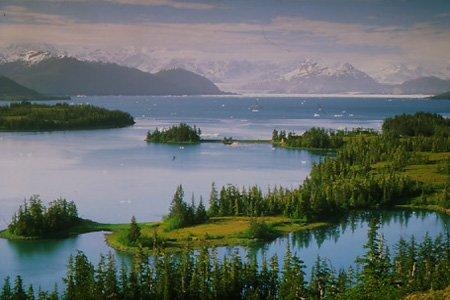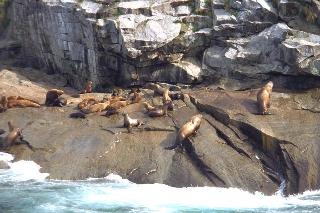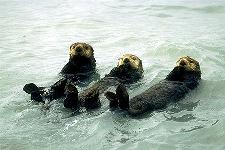 About
20,000 years ago, the Earth's climate cooled and the last of the great Pleistocene
ice ages occurred. Glaciers formed in the stream beds of the coastal plateau
and carved deep valleys. When the glaciers receded about 12,000 years ago, they
had scoured the Earth's crust down to the granites and carved out deep fjords
(glacially carved valleys filled with sea water) creating Prince William Sound
and the rugged, glacially sculpted Chugach Mountains.
About
20,000 years ago, the Earth's climate cooled and the last of the great Pleistocene
ice ages occurred. Glaciers formed in the stream beds of the coastal plateau
and carved deep valleys. When the glaciers receded about 12,000 years ago, they
had scoured the Earth's crust down to the granites and carved out deep fjords
(glacially carved valleys filled with sea water) creating Prince William Sound
and the rugged, glacially sculpted Chugach Mountains.
Prince William Sound, nestled in the coastal arc of Alaska's Chugach Mountain Range, has over 20 glaciers terminating at sea level; numerous others cling to precipitous mountainsides. Glaciers form because warm, low pressure systems sweeping in off the Pacific Ocean in the winter encounter the mountains, rise, cool and deposit their excess moisture. More snow falls in the long winter than melts during the short summer. The thick, accumulating snow layers compress into ice which gradually flows down to the sea as glaciers.
 The
face of Columbia Glacier is a sheer wall of ice, rising 250 feet from the
sea and spanning three miles across the bay. This river of ice flows
to the sea from the Chugach Mountains and blankets an area over 400 square
miles.
The
face of Columbia Glacier is a sheer wall of ice, rising 250 feet from the
sea and spanning three miles across the bay. This river of ice flows
to the sea from the Chugach Mountains and blankets an area over 400 square
miles.
Tidewater glaciers exhibit cyclical behavior. Columbia Glacier, the Sound's largest tidal glacier, entered the drastic retreat phase of its cycle in 1984 discharging huge quantities of icebergs that totally clogged the area behind its former moraine and often filled the outer bay with ice. In November of 1995, the glacier's retreat slowed and both the outer and inner bays became ice-free. It is too soon to know whether this is a temporary pause or whether the glacier has stopped retreating. However, the glacier's retreat has opened up new areas for plants and animals to colonize.
 This
rich mosaic of habitats supports one of North America's largest populations
of black bear. (Brown bear occur elsewhere in the Sound.) In late May and
June, black bear feed on sedges along the beach fringe and emerging herbs
on the avalanche slopes. In late July and August when the salmon return,
bears congregate along the stream banks, but when the blueberries ripen
they sped more time scouring the hillsides for patches of ripe berries.
In June, harbor seals pup on the icebergs from Columbia Glacier. At this
time, because seal pups have no blubber, they are extremely vulnerable
to hypothermia. So-called "transient' pods of killer whales hunt among
the icebergs and along the shores for harbor seals. During their August
molt, harbor seals again spend much of their time on icebergs. Icebergs
also provide perching and resting platforms for sea otters, river otters,
and birds such as bald eagles, black-legged kittiwakes, Arctic terns, glaucous-winged
gulls, and pelagic cormorants.
This
rich mosaic of habitats supports one of North America's largest populations
of black bear. (Brown bear occur elsewhere in the Sound.) In late May and
June, black bear feed on sedges along the beach fringe and emerging herbs
on the avalanche slopes. In late July and August when the salmon return,
bears congregate along the stream banks, but when the blueberries ripen
they sped more time scouring the hillsides for patches of ripe berries.
In June, harbor seals pup on the icebergs from Columbia Glacier. At this
time, because seal pups have no blubber, they are extremely vulnerable
to hypothermia. So-called "transient' pods of killer whales hunt among
the icebergs and along the shores for harbor seals. During their August
molt, harbor seals again spend much of their time on icebergs. Icebergs
also provide perching and resting platforms for sea otters, river otters,
and birds such as bald eagles, black-legged kittiwakes, Arctic terns, glaucous-winged
gulls, and pelagic cormorants.
On March 24, 1989, the Exxon
Valdez hit a reef nearby and spilled approximately 10 million gallons of
oil into Prince William Sound. Clean-up efforts ensued; however, much of
the region's wildlife was killed or endangered as a result of the environmental
disaster.

Page created 12/1/99 and last updated 12/1/99